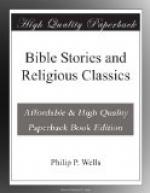stand there, wherefore he made the sign of the cross
to be taken thence. On a time as St. Patrick preached
in Ireland the faith of Jesu Christ, and did but little
profit by his predication, for he could not convert
the evil, rude and wild people, he prayed to our Lord
Jesu Christ that he would show them some sign openly,
fearful and ghastful, by which they might be converted
and be repentant of their sins. Then, by the
commandment of God, St. Patrick made in the earth a
great circle with his staff, and anon the earth after
the quantity of the circle opened and there appeared
a great pit and a deep, and St. Patrick by the revelation
of God understood that there was a place of purgatory,
in to which whomsoever entered therein he should never
have other penance ne feel none other pain, and there
was showed to him that many should enter which should
never return ne come again. And they that should
return should abide but from one morn to another, and
no more, and many entered that came not again.
As touching this pit or hole which is named St. Patrick’s
purgatory, some hold opinion that the second Patrick,
which was an abbot and no bishop, that God showed to
him this place of purgatory; but certainly such a
place there is in Ireland wherein many men have been,
and yet daily go in and come again, and some have
had there marvellous visions and seen grisly and horrible
pains, of whom there be books made as of Tundale and
others. Then this holy man St. Patrick, the bishop,
lived till he was one hundred and twenty-two years
old, and was the first that was bishop in Ireland,
and died in Aurelius Ambrose’s time that was
king of Britain. In his time was the Abbot Columba,
otherwise named Colinkillus, and St. Bride whom St.
Patrick professed and veiled, and she over-lived him
forty years. All these three holy saints were
buried in Ulster, in the city of Dunence, as it were
in a cave with three chambers. Their bodies were
found at the first coming of King John, King Harry
the second’s son, into Ireland. Upon whose
tombs these verses following were written: Hic
jacent in Duno qui tumulo tumulantur in uno, Brigida,
Patricius atque Columba pius, which is for to say
in English: In Duno these three be buried all
in one sepulchre: Bride, Patrick, and Columba
the mild.
Men say that this holy bishop, St. Patrick, did three great things. One is that he drove with his staff all the venomous beasts out of Ireland. The second, that he had grant of our Lord God that none Irish man shall abide the coming of Antichrist. The third wonder is read of his purgatory, which is more referred to the less St. Patrick, the Abbot. And this holy abbot, because he found the people of that land rebel, he went out of Ireland and came in to England in the Abbey of Glastonbury, where he died on a St. Bartholomew’s day. He flourished about the year of our Lord eight hundred and fifty.




